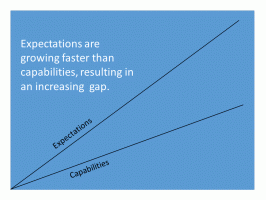Widgetized Section
Go to Admin » Appearance » Widgets » and move Gabfire Widget: Social into that MastheadOverlay zone
Closing the Gap: Expectations Versus Capabilities
The views expressed are those of the author and do not necessarily reflect the views of ASPA as an organization.
By Anthony Buller
July 10, 2015
Consider two trend lines. First, public expectations for services rendered after disaster. Call this the “service expectations line” and you should have it rising very quickly over time. Second, consider a line we’ll call “service capabilities,” which represents the ability of all the various responding partners to meet individual and community needs after calamity. This line, I argue, is growing, but not as fast as expectations. Thus the gap increases over time. This column explores the main way we can close that gap.
Before we go there, though, I should briefly speak to those two lines some more.
Growing public expectations
If you simply consider the frequency of federally declared disasters, you would see that expectations are growing. We also have to look at the increasing vulnerability of individuals and their communities due to climate change, investment in at-risk areas and urbanization, which creates greater reliance on fragile systems. Some very good pressures are at work too such as improving services for individuals with access and functional needs.
Growing capabilities
New partners are contributing to disaster response and recovery. Plans are being developed, training is occurring and we are exercising to test ourselves. At all levels of government we can identify improvement to programs and the efficiency of service delivery. Weare identifying and addressing growing vulnerabilities like cyber threats. Investment continues in risk mitigation and equipping responders. The homeland security and emergency management fields are maturing with greater access to higher education and emphasis on credentialing. But despite all this, the gap is growing.
Closing the gap

The emergency management community has been hard at work trying to slow the rise of public expectations (bringing the top line down) and to build capacities (bringing the bottom line up). However, results have been mixed at best. I believe the focus of our efforts should be on tasks that move both lines toward one another at the same time.
The solution is to meaningfully engage more partners. Throughout the prior five columns, my primary theme has been engagement. First, I addressed how public administrators should prepare to engage with emergency management. Second, I explained how to plug into the network about disaster management. Third, I interviewed a former city manager turned emergency manager with the conclusion being that all levels of government need to collaborate better. Fourth, I encouraged public administrators to fully engage the office of their executive. Fifth, I argued that we should engage those who are suddenly paying attention right after disaster.
This, as my final column, I’ve now shared the root of the importance of engagement: bringing more partners into the network of emergency management works to substantially reduce the gap between the rising expectations of service delivery and the capabilities that providers can deliver. How? As more and more outreach and engagement occurs, more and more people come to understand their risks and the limitations of service providers. They develop awareness and empathy.
On the other hand, they also learn how to contribute, individually or as part of an organization, to the disaster response and recovery effort and better prepare themselves and their organization to withstand disaster.
I’ve seen engagement reduce the gap with hundreds of organizations over my years with emergency management. But there is still work to be done.
I’d invest to ensure that emergency management at all levels is building relationships with key partners. I would encourage grant dollars be used for engagement. I would also require more meaningful engagement before awarding grant dollars. As one simple example, some emergency managers have no relationship with local housing authorities even though we know the critical role housing plays after disaster. Countless other partnership gaps remain.
It has been a pleasure writing this monthly column and I really look forward to reading from new columnists on the subject of emergency management.
Author: Anthony Buller, CEM® has a decade of experience as an emergency manager for the Federal Emergency Management Agency (FEMA). He can be contacted at [email protected]. The views expressed are those of the author and not FEMA.


Follow Us!